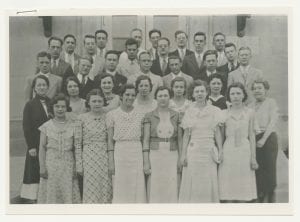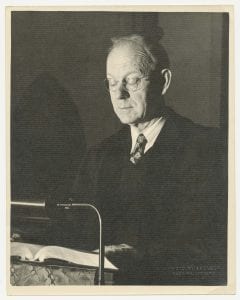By: Hannah Bourne, Bicentennial Intern, Class of 2019, History & Political Science and Communication, Kokomo

The dream of accessible higher education for a small, struggling town in the midst of the Great Depression found its beginning in a house located at 508 West Taylor Street in Kokomo, Indiana. The Kokomo Junior College, founded by John and George Beauchamp in 1932, was the precursor to what has now become Indiana University Kokomo.
A New Idea
The two brothers from Wabash, Indiana, believed that education should be accessible for those who wished to pursue it, no matter their economic status. They eventually formed the idea of the Kokomo Junior College, which operated for thirteen years before a merger with Indiana University created the IU Extension Center in Kokomo.[1]
The Junior College is considered a “product of the Great Depression,” formed at a time of economic desperation when unemployment rates were frighteningly high. For many, jobs were simply nowhere to be found. John Beauchamp, recently graduated from the University of Michigan with an M.A., found himself in this same seemingly hopeless situation. However, George Beauchamp wasn’t ready to give up yet. If there were no teaching jobs to be found, then George would have to create them himself.
After discussing ideas with their family, the brothers agreed that opening a junior college in Indiana could provide teachers with much-needed jobs and students with an affordable, local opportunity for higher-education. “We all sat around the dining room table with a map of Indiana searching for the largest city farthest away from an existing college or university. Kokomo looked to be the best choice,” George reminisced. The Beauchamps were right about Kokomo’s need for the junior college.
In 1931, only eight of two-hundred Kokomo High School graduates were able to go to college. With the Great Depression continuing to hold the U.S. in its grip, the odds for Kokomo students to attend college weren’t improving.

The Kokomo Junior College
With the help of Kokomo school superintendent Clarence V. Haworth, the Beauchamps were able to secure classroom space in the Kokomo YMCA for $1 per year. The brothers began to organize their new junior college using George’s $400 in savings. John was appointed as the first dean and began arranging classes and finding suitable faculty members to teach them.
Meanwhile, George worked to persuade state colleges such as Purdue University and Indiana University to accept the transcripts of Kokomo Junior College students. This was no easy task, as the other universities saw the junior college as a competitor and had no desire to support its operation.
Eventually, George convinced them that the two-year institution would not draw students away; on the contrary, George argued, after two years, the students may have saved enough money to go and finish their degree at a four-year institution.
The universities agreed to recognize Kokomo Junior College transcripts on the condition that, after a term of probation, the transfer students would receive credit upon earning satisfactory grades.
The Beauchamps determined that they would need at least 40 students to enroll in the school. John’s fiancée, Ruby Walker, began seeking out high school seniors to recruit as the first class of the new Kokomo Junior College. Her efforts paid off when 50 students showed up to enroll, and the college successfully opened in September of 1932. However, as the Beauchamps and their colleagues soon discovered, founding the school was only the beginning of the college’s challenges.

College Life
The college was in constant danger of not meeting its expenses. The initial group of three faculty members could only be compensated a meager $50 per month for their efforts. However, the Kokomo Junior College was remarkable for the strong sense of community that developed between students, faculty, and staff despite its small size and never-ending financial struggles.
The Beauchamps attempted to create a sense of college life at the Kokomo Junior College.[2] Over the course of the school’s existence it boasted a student newspaper called The Mirror, a basketball team, track team, choir, and drama club. The students held parties, dances, and other recreation activities, and the college’s commencement ceremonies were said to have possessed all the dignified formality of other universities.[3]

Enrollment gradually grew, and with more students came a greater sense of stability. In 1934, George Beauchamp left the school to teach at Northwestern University and in 1936 John Beauchamp decided to pursue a career in law. Though it was clear that the college was serving an important need within the community, the school struggled to find someone willing to take over the responsibility of being dean.

A group of men and one woman who had been instrumental in the development and success of the college purchased the school from the Beauchamp brothers and formed a new board of trustees to oversee the college’s administration. Dr. Hurd Allyn Drake became president of the board and C.V. Haworth was selected as chairman. The board moved the school out of the Kokomo YMCA to a new location at 508 West Taylor Street in Kokomo.
L. Ward McReynolds came to Kokomo Junior College to teach zoology in the fall of 1938. McReynolds is the perfect example of the multiple roles each faculty member had to play in order to keep the doors of the little college open. When the chemistry teacher resigned, McReynolds took on chemistry and “added botany, human physiology, and personal hygiene” as well as continuing to teach zoology.[4]
In 1939, McReynolds was elected dean of the school. He wrote, “I continued as dean, acted as registrar, taught such biology and chemistry as was needed and did a goodly portion of the janitorial work from the spring of 1939 until the close of the school year 1944-45.”[5]

Indiana University Comes to Kokomo
Dr. Hurd Allyn Drake retained the office of president from 1936 until the school was closed in 1945. McReynolds praised the “loyalty and hard work” that Dr. Drake demonstrated in his position as president and attributes the continuation of the college through major crises to his perseverance.[6]

Eventually, the financial situation of the school forced the board to consider pursuing a merger with Indiana University. In a unanimous decision by the Kokomo Junior College trustees, the “furniture, equipment, supplies and other properties owned by the College” were sold to Indiana University in 1945. The letter discussing the sale of the college to IU is dated just at the time when the U.S. was about to celebrate V-J Day (victory over Japan) at the close of World War II.
In fact, V-J Day is mentioned as a concern over the timing of the merger’s announcement: “He also called attention to the probability of running into a conflict with announcement of V-J day which would garble and greatly reduce the value of the publicity which we all desire to be as effective as possible.”[7]
The words found at the end of this letter are both profound and exciting in the present day: “It seems to me that the way is now clear for us to proceed with our plans to make our program a success for the citizens of Kokomo and the surrounding area. We shall of course be happy to do our best.”[8]
In 1945, IU adopted the Kokomo Junior College and transformed 508 West Taylor Street into the Indiana University Extension Center at Kokomo. The merger marks the beginning of Indiana University’s legacy in the Kokomo community.
The spirit of IU Kokomo lies in the spirit of 508 West Taylor Street and the hardy group of scholars who formed Kokomo Junior College through their dedication, perseverance, and passion for higher education. Indiana University Kokomo has continued to fulfill the promise of higher education in this community for nearly 75 years.
For part two of this blog, please visit: https://blogs.iu.edu/bicentennialblogs/2018/07/05/the-transition-of-kokomo-junior-college-to-indiana-university-kokomo/
Notes
[1] Dow Richardson, Going to College at Home: Forty Years of Higher Education in Kokomo 1945-1985 (Bloomington, IN: Indiana University Publications, 1985), 1.
[2] Ibid., 8
[3] L.Ward McReynolds statement. Courtesy of IU Kokomo Archives.
[4] Ibid.
[5] Ibid.
[6] Ibid.
[7] Kokomo Junior College Correspondence. August 13, 1945. Written by R.E. Cavanaugh to Hurd Allyn Drake. IU Kokomo Archives.
[8] Ibid.
Loved reading much history I had not known..Enjoyed seeing my constitutional law professor B.R. Davidson in a photo. Thanks Danny Strickland